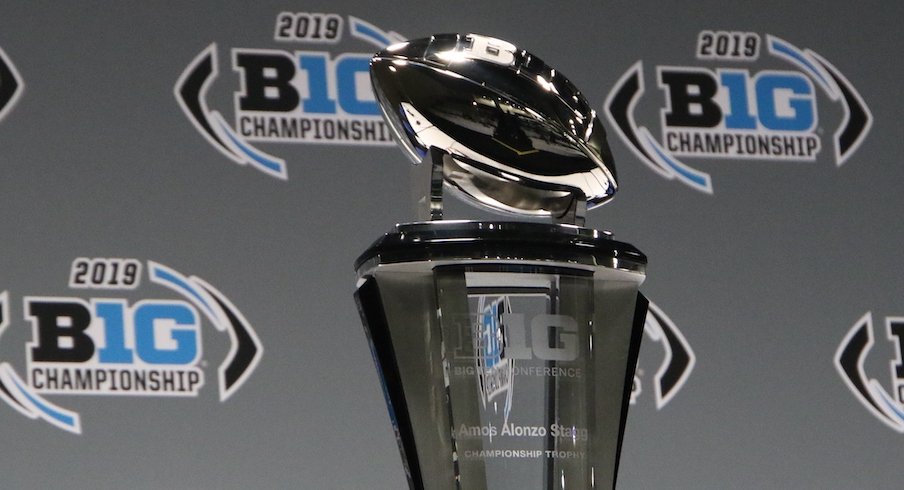With three games already canceled in the Big Ten this season, the race to play in this year’s conference championship game has the potential to get confusing.
The Big Ten released updated tiebreaker procedures prior to the start of the 2020 season to account for the possibility that some teams could play more games than others this year and that teams in the same division might not even play head-to-head games against each other. That has now become reality with Wisconsin canceling its games against Nebraska and Purdue and Maryland canceling its game against Ohio State – games that can’t be rescheduled due to the lack of flexibility the Big Ten left itself by starting an eight-game season on Oct. 23-24.
You’ll find if you take a look at those tiebreaker procedures, though, that the formula is far from simple. So, we’ve taken our best effort at sifting through them for you and explaining how those tiebreakers could play out for Ohio State and other Big Ten contenders in a variety of scenarios.
Before we continue forward, let’s start with the most straightforward scenario for the Big Ten East: If Ohio State and Indiana play next week, and the winner of that game also wins the rest of its games to remain undefeated, that team will win the East outright and play in the Big Ten Championship Game, so long as it does not have more than two total games canceled. As of now, there’s no reason to believe that game is any less likely to be played than any other game, given that Maryland was the team that had the COVID-19 spike prompting this week’s cancellation.
But because three of the five Big Ten teams who have already had games canceled are also three of the five Big Ten teams who are currently undefeated, it’s become a real possibility that one or both championship game berths could be decided by a tiebreaker between teams who have played an uneven number of games, and possibly even between teams who haven’t played each other.
We explore some of the scenarios that are now in play and how the tiebreaking procedures would determine who gets the chance to compete for a conference title in Indianapolis.
What happens if a team has more than two games canceled?
Unless the average number of games played by all teams throughout the conference drops below six, any team that plays fewer than six games will not be eligible for the Big Ten Championship Game. For Wisconsin, that means a cancellation of any one of its five remaining regular season games would likely eliminate the Badgers from championship contention. Ohio State would still be eligible for the Big Ten Championship Game if it had one more game canceled, but it can’t have two more games canceled.
What happens if two teams in the same division finish unbeaten?
In the East, this scenario would only be on the table if Ohio State and Indiana don't play, since they are the only two remaining unbeaten teams in their division. But in the West, this scenario would come into play if Wisconsin and Purdue were to both run the table, given that the game between them has already been canceled and will not be made up.
| Team | Record |
|---|---|
| EAST | |
| INDIANA | 3-0 |
| OHIO STATE | 3-0 |
| MARYLAND | 2-1 |
| RUTGERS | 1-2 |
| MICHIGAN STATE | 1-2 |
| MICHIGAN | 1-2 |
| PENN STATE | 0-3 |
| WEST | |
| NORTHWESTERN | 3-0 |
| PURDUE | 2-0 |
| WISCONSIN | 1-0 |
| IOWA | 1-2 |
| MINNESOTA | 1-2 |
| NEBRASKA | 0-2 |
| ILLINOIS | 0-3 |
Because the tiebreakers are based on the number of losses rather than the number of wins, this is where things really start to get complicated,
Even in the scenario that Purdue finished 7-0 and Wisconsin finished 6-0, Purdue’s seventh win would not be the first tiebreaker. Instead, the Big Ten West’s championship game representative would be determined based on the cumulative winning percentage of each team’s non-divisional opponents. Since Purdue and Wisconsin are both scheduled to play Indiana, the championship game representative would ultimately be determined by whether Michigan (who Wisconsin plays) or Rutgers (who Purdue plays) – both currently 1-2 – finishes with a better record.
In the event that Indiana and Ohio State did not play next week but both won the remainder of their games, that tiebreaker would almost certainly favor the Hoosiers, given that Wisconsin and Purdue currently have a combined 3-0 record while Nebraska and Illinois (Ohio State’s non-divisional opponents) currently have a combined 0-5 record.
What happens if two (or more) teams finish first in a Division with one loss, but one has more wins?
If the teams played each other, that won’t matter; head-to-head result will take precedence over winning percentage. So if, for example, Indiana finished 7-1 and Ohio State finished 6-1 but Ohio State defeated Indiana in their head-to-head game, the Buckeyes would represent the East in the Big Ten Championship Game even though the Hoosiers have a higher winning percentage.
If Wisconsin was to lose one game but beat Northwestern, the Badgers would hold the Big Ten Championship Game tiebreaker over Northwestern with a 5-1 record even if Northwestern is 7-1. If Northwestern tied with either Purdue or Wisconsin for the division lead with one loss, the winner of their head-to-head game would represent the West in the Big Ten Championship Game as long as that head-to-head game happens. (Correction: This section previously referenced a possible head-to-head tiebreaker for Wisconsin over Purdue, but that is no longer possible since the Badgers' game against the Boilermakers was canceled.)
What happens if two or three teams that didn’t play each other tie for the division lead with one loss?
It’s not exactly a likely outcome, but there is now a scenario where this would come into play for Ohio State. If the Buckeyes were to lose one game, Indiana was to lose two or more games and Maryland was to win out, then the Buckeyes and Terrapins would tie for the division lead with one loss each.
In that scenario, it’s likely the tiebreaker would go in Maryland’s favor. If the Buckeyes lost to anyone but Illinois, Maryland would earn the championship game berth on the basis of having a better divisional record, since its loss was in a cross-divisional game against Northwestern. If the Buckeyes lost to Illinois, then the tiebreaker would fall back to the cumulative winning percentage of non-division opponents, where Maryland would currently have the edge based on Northwestern and Minnesota having a combined 4-2 record while Nebraska and Illinois are 0-5.
In a scenario where Maryland beat Indiana, Indiana beat Ohio State and all three teams finished with one loss, Indiana would advance to the Big Ten Championship Game. Maryland would be the first team eliminated from the tiebreaker because of its loss to Penn State (since neither Indiana nor Ohio State) would have any other losses against Big Ten East, and the Hoosiers would advance because of their win over the Buckeyes.
In a Big Ten West scenario in which Northwestern defeats Purdue and Wisconsin defeats Northwestern – or, Northwestern defeats Wisconsin, and Purdue defeats Northwestern – and all three teams finish with one loss, both scenarios would favor Northwestern. With no head-to-head game against one another, either Purdue or Wisconsin would be eliminated first based on losing to a non-divisional opponent or another team in the division, leaving Northwestern to win the head-to-head tiebreaker with the other team.
How have the already-canceled games changed the Big Ten Championship Game race?
If Ohio State gets to play the rest of its regular season games and wins all of them, the canceled game against Maryland won’t change anything. If the Buckeyes go 7-0 in the regular season, they’ll win the Big Ten East.
If Indiana defeats Ohio State next week, the Buckeyes will need the Hoosiers to lose two games to have a chance to play in the Big Ten Championship Game, but that was already the case before the Maryland game was canceled. Maryland could benefit from avoiding Ohio State in a scenario where both teams finish 6-1 and tie for the Big Ten East title, but the Buckeyes can still prevent any chance of that happening by winning out.
The canceled game between Wisconsin and Purdue creates the possibility that two teams could finish undefeated in the Big Ten West and that one of them could be left out of the Big Ten Championship Game even if it gets to play and wins the rest of its regular season games, but the odds are against that happening.
Northwestern would have the upper hand if those three teams were to finish in a three-way tie, and it would have a clear path to the Big Ten Championship Game if it beats both Purdue and Wisconsin. But it also still has to play both of those teams, and potentially still has to beat both of them to win the West, whereas the Badgers and Boilermakers don’t have to play each other, removing the certainty that at least one of them will lose to someone else.
If one team in each division finishes undefeated, or at least with one less loss than every other team in its division, that would make it much simpler to know which two teams will vie for this year’s conference title in Indianapolis. If tiebreakers end up coming into play, however, hopefully the above answers will provide some clarity on how the championship game participants will be decided.


